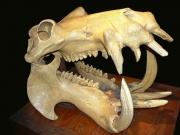Difference between revisions of "Hippopotamus teeth"
Jump to navigation
Jump to search
(username removed) |
|||
| (3 intermediate revisions by 3 users not shown) | |||
| Line 1: | Line 1: | ||
| − | [[File:03.1703-SC113060.jpg|thumb|]] | + | [[File:03.1703-SC113060.jpg|thumb|Carved hippopotamus ivory<br>MFA# 03.1703]] |
== Description == | == Description == | ||
| + | [[File:Hipposkullvt.jpg|thumb|Hippopotamus ''Hippopotamus amphibius'']] | ||
| + | Large upper and lower canine teeth from the hippopotamus (Hippopotamus amphibius). The upper teeth can grow to 20 cm while the lower tusk can grown to 70 cm. Hippopotamus teeth have been used as ivory after the thick, hard enamel layer is removed. Of the materials that have been used as ivory substitutes, hippo teeth are the hardest and most opaque (Thornton 1981). They are close-grain, polish to a high gloss and rarely yellow with age. Microscopically, the hippo teeth may exhibit an irregular wavy pattern but they do not exhibit the layered ring structure and peeling that are found in elephant ivory. See also [[ivory]]. | ||
| − | + | [[File:Hippopodvt.jpg|thumb|Hippopotamus ''Hippopotamus amphibius'']] | |
| − | |||
| − | [[File: | ||
| − | |||
| − | ''Hippopotamus amphibius'']] | ||
== Synonyms and Related Terms == | == Synonyms and Related Terms == | ||
| − | ivory substitute; hippopotamus ivory; Hippopotamus amphibius; | + | ivory substitute; hippopotamus ivory; ''Hippopotamus amphibius''; |
| − | == | + | == Physical and Chemical Properties == |
UV autofluorescence is bluish white with some purple. | UV autofluorescence is bluish white with some purple. | ||
| Line 17: | Line 15: | ||
{| class="wikitable" | {| class="wikitable" | ||
|- | |- | ||
| − | ! scope="row"| Density | + | ! scope="row"| Density |
| − | | 1.80-1.95 | + | | 1.80-1.95 g/ml |
|} | |} | ||
| − | == | + | ==Resources and Citations== |
| − | + | * J.Thornton,"The Structure of Ivory and Ivory Substitutes", AIC Preprints, Philadelphia, 1981, p.173-181 | |
| − | J.Thornton,"The Structure of Ivory and Ivory Substitutes", AIC Preprints, Philadelphia, 1981, p.173-181 | ||
| − | |||
| − | |||
| − | |||
| − | |||
| − | |||
| − | |||
| − | |||
| − | |||
| − | |||
| − | |||
* ''The Dictionary of Art'', Grove's Dictionaries Inc., New York, 1996 Comment: F.Minney, "Ivory" | * ''The Dictionary of Art'', Grove's Dictionaries Inc., New York, 1996 Comment: F.Minney, "Ivory" | ||
Latest revision as of 13:42, 27 August 2022
Description
Large upper and lower canine teeth from the hippopotamus (Hippopotamus amphibius). The upper teeth can grow to 20 cm while the lower tusk can grown to 70 cm. Hippopotamus teeth have been used as ivory after the thick, hard enamel layer is removed. Of the materials that have been used as ivory substitutes, hippo teeth are the hardest and most opaque (Thornton 1981). They are close-grain, polish to a high gloss and rarely yellow with age. Microscopically, the hippo teeth may exhibit an irregular wavy pattern but they do not exhibit the layered ring structure and peeling that are found in elephant ivory. See also Ivory.
Synonyms and Related Terms
ivory substitute; hippopotamus ivory; Hippopotamus amphibius;
Physical and Chemical Properties
UV autofluorescence is bluish white with some purple.
| Density | 1.80-1.95 g/ml |
|---|
Resources and Citations
- J.Thornton,"The Structure of Ivory and Ivory Substitutes", AIC Preprints, Philadelphia, 1981, p.173-181
- The Dictionary of Art, Grove's Dictionaries Inc., New York, 1996 Comment: F.Minney, "Ivory"
- Hermann Kuhn, Conservation and Restoration of Works of Art and Antiquities, Butterworths, London, 1986
- Oppi Untracht, Jewelry Concepts and Technology, Doubleday & Co., Inc., New York City, 1985
- Benjamin Burack, Ivory and Its Uses, Charles E. Tuttle and Co., Vermont, 1984


